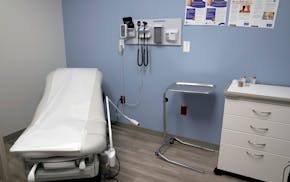Amid the depths of the Great Recession, Norm Skalicky said his St. Cloud bank had all but given up hope of making new commercial loans.
"We just didn't dare put anything on our books," said Skalicky, chief executive officer of Stearns Bank. "It was too risky. Everybody was afraid."
But the dark outlook at the $1.23 billion bank faded early last year. Manufacturers that had spent two years cutting back began to tap their credit lines again. Commercial real estate values, though still in decline, were no longer falling off a cliff. Most significant, fewer and fewer borrowers were defaulting on their loans. Stearns Bank reaped a $25 million profit last year, while its write-downs on troubled loans fell 60 percent.
It was a similar story across the state in 2010, as the banking industry finally showed signs of life after 2 1/2 years of steadily worsening results. Many banks have largely cleaned problem loans off their balance sheets, which has freed them up to make new loans. Meanwhile, businesses are starting to borrow again to finance their growth, though bankers say demand remains well below pre-recession levels.
The upshot: Banks are making much stronger profits, while loan growth remains tepid.
The Federal Deposit Insurance Corp. said in a quarterly report Wednesday that profits among Minnesota's 404 banks and thrifts nearly tripled to $207 million in 2010, from $75 million a year earlier. Bank write-downs on troubled loans -- a persistent curse on bank balance sheets -- declined 14 percent last year.
Yet, overall bank assets in Minnesota have inched up only slightly over the past year, suggesting that banks are still treading carefully.
"It's a recovery in inches, not in miles," said Patrick Donovan, CEO of St. Paul-based Bremer Bank, which has $7.9 billion in assets. "We're seeing an improvement, but it's not the big pop-back that you normally see" during an economic recovery.
There are signs that the long drought in commercial lending activity may be nearing its end. A number of Minnesota bank executives said businesses are starting to use more of their credit lines, to hire workers and replenish inventories.
Donovan estimates that Bremer's average commercial customer is using 35 percent of its available credit line, up from a low of 28 percent two years ago. Before the recession hit, the average commercial borrowers were using more than half of their existing credit lines, Donovan said.
With lending activity still subdued, banks are in a fierce battle for creditworthy customers. The competition has intensified, in large part, because banks that once specialized in financing builders and developers are now turning their attention to Main Street businesses. And larger banks, such as Minneapolis-based U.S. Bancorp, are moving downstream, putting more resources into small business lending.
Chuck Mueller, president and CEO of Fidelity Bank, a $373 million bank in Edina, said he's had to fight to keep his strong commercial clients. Some are getting two or three telephone calls a month from rival bankers. "The competition for sound, strong commercial accounts has become intense," he said.
In Minnesota, as in the rest of the country, banks are still trying to unwind troubled loans -- often backed by commercial real estate with sharply reduced values. Banks' nonperforming assets, or loans 90 days or more past due and unlikely to be repaid, rose to 3.95 percent of assets as of Dec. 31, up from 3.71 percent a year earlier.
About one-fifth of this state's banks are still losing money, and many of them have seen their capital levels fall to precariously low levels.
As of the end of 2010, a total of 10 banks statewide were technically "undercapitalized" by federal regulatory standards, according to Trepp, a New York data analytics firm. The banks include InterBank, a $600 million home lender in Maple Grove; RiverBank, a $430 million bank in Wyoming, Minn.; and Americana Community Bank, a $160 million community bank in Sleepy Eye, Minn., among others.
However, in a significant shift, even troubled banks are having some success raising money. A number of troubled Minnesota banks received large infusions of capital from investors last year. All told, bank owners and parent companies poured $86 million into their bank subsidiaries last year -- up from $72 million in 2008, according to Trepp.
This marks a significant change from two years ago, when banks that were starved for capital had few options. "More capital means there is optimism in the industry, and suggests maybe we've reached the bottom and we've started to come out of this," said Loren Prairie, president of Prairie Consulting Inc., a bank consulting firm in Apple Valley.
The stronger results from Minnesota lenders mirrored national trends. The FDIC said U.S. banks had net income of $21.7 billion in the fourth quarter and $87.5 billion for the year, the highest since 2007. However, the number of institutions on the FDIC's "troubled" bank list rose to 884 in the fourth quarter from 860 in the previous quarter, the agency said.
Chris Serres • 612-673-4308
Characters enter the public domain. Winnie the Pooh becomes a killer. Where is remix culture going?
China's economy grew 5.3% in first quarter, beating expectations
NASA confirms mystery object that crashed through roof of Florida home came from space station
